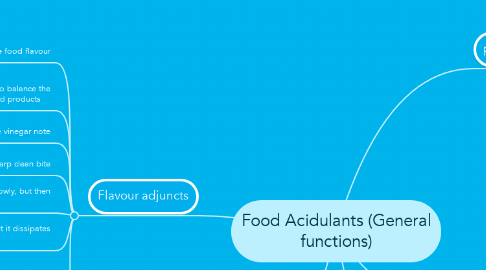
1. pH control agents
1.1. To obtain certain pH range in product formulation
1.1.1. Example: in fruit jam formulated with pectin, a pH range between 2.9-3.4 is critical to obtain desired gel setting.
1.1.2. Acidulant reaction with baking soda is essential in the leavening action of the carbon dioxide.
1.1.3. Maintain the acidic pH and the tartness of carnoneted beverages.
1.1.4. Acidification may also benefit product that use preservatives such as sodium benzoate, which has optimum effect in the acid range.
1.1.5. Buffering capacity
1.1.5.1. Buffering is the ability of a weak acid/salt combination to control the amount of free hydrogen ions.
1.1.5.1.1. Provide protection from pH dependent effects like colour or flavour changes.
1.1.5.1.2. To maintain acidic fermentation processes.
1.1.5.2. Citric acid has the widest effective buffer range which is from pH2.5 to 6.5.
1.1.5.3. Tartaric acid can only be used for buffering between pH3.0 and 4.5.
2. Preservatives
2.1. 1. Stop growth or enhanced the effectiveness of heat sterilization or the anti-microbial effect of solutes
2.2. 2. Destroy the organism in extreme cases
2.3. 3. Controlled acid fermentation process
2.4. 4. As antibrowning agent to maintain the normal flavour, colour and texture of several canned fruits and vegetables.
3. Chelating agents/antioxidant synergists
3.1. Citrate and phosphates have the ability to form ring structures with metal ions, a process known as chelation to prevent the metal ions from reacting with other materials or from acting as a catalyst for reactions.
3.1.1. The formation of a stable, water soluble chelate is referred to as sequestration.
3.2. Citric acid is the strongest chelating agent of the common food acids.
3.3. Lactic, malic and tartaric acids can also provide a useful degree of chelation.
3.4. Used as synergists for antioxidants in the preservation of fats and oils and in food products cotaining fatty compounds.
3.4.1. Example: BHA and BHT, ascorbates
4. Flavour adjuncts
4.1. Modify or enhance food flavour
4.1.1. Example of foods: hard candies, gelatin desserts, carbonated/ noncarbonated beverages, jellies, preserves, toppings
4.2. Add the tartness required to balance the excessive sweetness of food products
4.3. Acetic acid gives a distinctive vinegar note
4.3.1. It wouldn't enhanced a delicately flavoured fruit beverage
4.4. Citric acid gives a sharp clean bite
4.5. The acidity of malic acid build slowly, but then lingers.
4.6. Fumaric acid taste lingers but it dissipates quickly with citric.
4.7. Enhancement of certain flavours requires combination of the flavour with appropriate acids
4.7.1. Example: tartaric acid in combination with grape flavour
4.7.2. Example: phosphoric acid with cola flavours
4.7.3. Citric, furmaric and malic acids have a broader spectrum of utility as they are compatible with most fruit and berry flavours.
5. Control of gelation and coagulation
5.1. Play a significant role in the gelation of pectin and algins.
5.1.1. For gelling high methoxyl pectin, the pH must be adjusted to 2.5 to 3.5.
5.1.1.1. In the production of direct acidified cheese products, tofu and similar products that required protein coagulation, using acidulants provides precise pH control.
